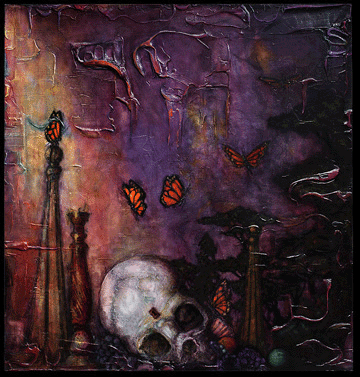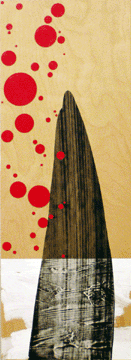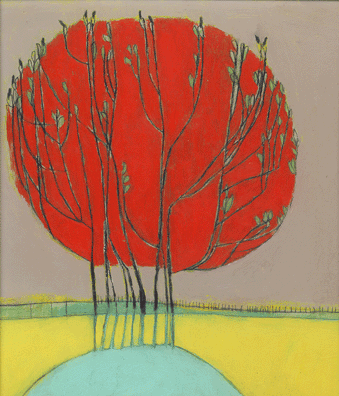Diverse Styles at Art-a-Whirl: 4 (four) at Rogue Buddha Gallery
The 4 (four) exhibition at the Rogue Buddha Gallery (showing through June 10th) brings together four of Minneapolis better painters, and, by doing this, it heartily succeeds, writes Alex Starace.




The Rogue Buddha Gallery’s current exhibit, “4 (four),” provides a glimpse of the variety of painting styles available in Minneapolis. In doing so, it demonstrates not only the artistic energy found in our community, but also the idiosyncratic nature of art itself: there is no “best” way to make a painting, nor can good art be manufactured – it must come from a highly personal view of the world and must be expressed in the artist’s unique voice. That four such local artists are currently on display at the Rogue Buddha is much to the city’s and gallery’s credit; here we have a worthwhile collection.
The first artist is Michael Thomsen, whose paintings/assemblages resemble dusty carnival backrooms piled with unwanted esoterica. His Round About, the most wonderful piece in the exhibit, is a large painted canvas with an intricate, three-dimensional Buddhist-like shrine jutting from the middle of the picture plane. Or perhaps the jutting object is a fortune-teller’s Love-o-Meter at a gypsy fair. It’s hard to say, but, in essence, the shrine/Love-o-Meter is the work.
Out of it stretches a white porcelain hand with an orb in its palm. The hand is giving a benediction and within the orb, if you peer closely, you can see a woman in Renaissance-festival clothing, sprawled out on a chair on a deck, holding a glass of wine and listening to a phonograph. Above her hovers a pregnant, yellow-off-white moon. And this is just one little window found in the massive shrine; there’s also a stage holding a court jester, a nearly nude dancer, a pair of die, and a series of miniature Redcoats. Surrounding the stage are electric, fake orange flames, while a spooky, garish red glow filters down from the top of the shrine; this is a piece you have to plug into the wall. Also to be seen: a purple/aqua mask, horns, fake fern leaves, moving holograms, and what appear to be miniature icons.
The three-dimensional clutter vivifies the piece’s Rosicrucian aesthetic: the work so emphatically succeeds because it is a built-up, living object, an object constructed entirely out of moderately-interesting, arcane crap. It transforms kitsch and junk into a sculpture, a testament to a lifestyle and a worldview, and, like all great visual art, one has to see it to really understand it.
In marked contrast to Thomsen’s heaping pieces, painter Yuri Arajs gets more mileage out of simple red circles than seems possible. In his eight pieces on display, he uses exactly three colors: black, white, and bright red. (Though, in fairness, in half his pieces he paints on birch plywood, giving him brown as a fourth color.) In Monolith #6, four monoliths sit in an ocean of white. Above is a line of red circles that stretch down between the monoliths, down to the ocean, forming a pattern, as if he took many photo exposures of a rock formation in order to document the falling of the sun. The red circles – their starkness and brightness – are mesmerizing. Arajs is clearly aware of this: in Red Floral #3, he combines (on a pure white background) a single red circle with a single calligraphic brush stroke and shows us that the red will catch us anywhere, that the simplicity of shape and color will always have us in its grasp.
Equally skilled in her use of shape is Jennifer Davis, whose painting, Flora #3, also relies on circles. It’s a child-like drawing: multi-colored circles on top with line-like stems that extend down to the orange grass below. The stems and blooms form a rich abstract pattern, while still being easily interpretable in a literal sense: it’s flowers in a garden. Similarly effective is Shelter, in which a copse is outlined (and backlit) by the sun. The trees’ shadows are turquoise while the fields are yellow and green. The sun is deep red and the sky is a blue-off-white. As an abstract work, it has all the broad pastels and open spaces necessary to give it a soft, easy feel. But the visual texture of the branches and the black hatch-marks of the fence in the distance add intricacy; one wants to look at Shelter for a long time. Not only is the duality of abstraction and figuration pleasing, but the subtle details, such as the little birds perched on the trees, reward careful and patient gazing.
Nicholas Harper’s paintings, on the other hand, don’t reward gazing so much as induce double-takes. In Susanna, a woman stands as though posing for a photograph. As with all Harper’s figures, she has a freakishly long neck (about a fifth the length of her body) and a lack of shoulders or upper arms. On her head she’s wearing a veil-like cloche that matches her see-through blouse. It’s a semi-nude made all the stranger by the woman’s long skirt, or rather that her forearms and hands are politely resting in front of her skirt at a level where one would guess her knees are located. Susanna’s bodily proportions are truly bizarre – and all of Harper’s subjects (Ariel, Paris, etc) are similarly proportioned. Furthermore, each posed woman has a transfixed look on her face, making it hard to tell if she’s demonic, or just really doped up – but the result is a sense of extreme eeriness.
The eeriness of Harper’s work dovetails nicely with that of Thomsen’s, just as the starkness of Davis and Arajas compliment each other. As a whole, it’s a nice grouping and the show is worth seeing. However, this not to say that “4 (four)” is without problems (For example, Thomsen’s two-dimensional pieces most resemble a mural on the side of a Tilt-A-Whirl; it’s a bit too easy to wonder if Arajas would be helpless without his red circles; and Harper’s technique and style are not nearly as original as his forms), but that here, currently at the Rogue Buddha Gallery, the artists shown are articulate enough to speak through their medium. A significant achievement, one that seldom leaves a gallery-goer disappointed.